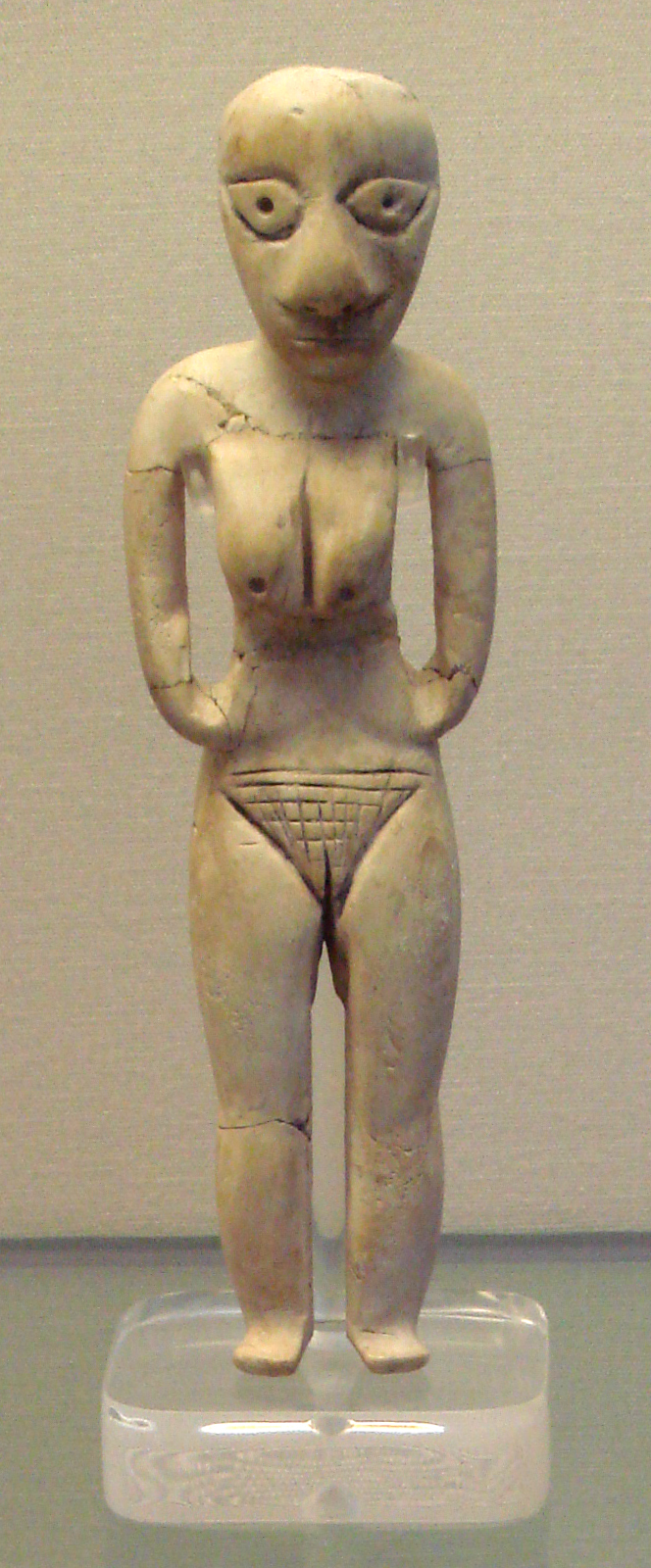 |
Badarian figurine |
Badarian Culture
The Badarian people lived in Upper Egypt, on the eastern bank of the Nile, from approximately 5000 BC to 4400 BC. Though they were a semi-nomadic people, they formed small settlements and began to cultivate grain and domesticate animals.

They buried their dead in small cemeteries on the outskirts of these settlements, and also conducted ceremonial burials for some of their domesticated animals. Although the graves themselves were simple, the deceased was buried with fine ceramics, jewellery, cloth and fur, and they usually included a finely crafted figurine of a female fertility idol. They did not mummify their dead, instead burying them in a foetal position, facing west (towards the setting sun).
 |
| Badarian relics |
Naqadan Culture
The Naqadan culture took over from the Badarian around 4500 BC and became arguably the most important prehistoric culture in Upper Egypt. It is named after the city of Naqada where many of the archaeological evidence for the period was found.
Naqada I
The early phase (Naqada 1, also called Amratian because of deposits found near the village of that name) ran in parallel to the Badarian culture, but slowly replaced it. They also lived in small villages and they developed the cultivation of the Nile valley, but the culture is most notable for the increase in artistic accomplishment and the proliferation of bearded male figures in addition to the female fertility figures.
 |
 |
 |
Each village had its own animal deity which was associated with the clan of the villagers. This formed the basis of the nome system which divided Egypt into regions represented by their totems.
In Naqada I graves, the deceased were buried with statuettes to keep them company in the afterlife. These were the forerunners of ushabti figures found in Egyptian tombs. Along with these figures, the dead person was buried with food, weapons, amulets, ornaments and decorated vases and palettes.
Naqada II
The Naqada II (also known as Gerzean due to finds near the village of that name) phase began around 3500 BC. This culture mastered the art of agriculture and the use of artificial irrigation, and no longer needed to hunt for their food. The people started live in towns, not just villages, creating areas of higher population density than ever before.
The culture continued to develop their artistic tendencies, creating new styles of pottery and more intricate carving. Many animal-shaped and shield-shaped palettes (used for mixing cosmetics) have been recovered. They form a clear link in development towards the ceremonial palettes of the early dynastic period (eg the Narmer palette). They also developed their skills in metalworking, in particular copper which they traded with the ancient peoples of Mesopotamia and Asia. The introduction of cylindrical seals (a typically Mesopotamiam device) showed that their culture was influenced by their neighbours, but the familiar Egyptian gods Hathor, Ra and Horus also date to this period.
 |
 |
 |
Their burial rituals also changed. They created rectangular graves whose walls were lined with masonry or wood, and the body was not specifically oriented towards the setting sun. There was a marked difference in the quality of grave goods between the rich and poor and many contained pottery which had been ritually shattered during the funeral.

Architecture also took a leap forward during the Naqada II period. A palace and ritual precinct was constructed in Nekhen (Hierakonpolis), which was the cult centre of Horus of Nekhem. It has a large oval courtyard, surrounded by small buildings, and is clearly the precursor to the ritual precincts of the Early Dynastic Period. Features of the complex (built of timber and matting) are echoed in the construction of Djoser’s pyramid complex.
Naqada III
Naqada III (also known as “Semainean”) was a short period from 3200 to 3000 BC which is often referred to as the protodynastic period, or Dynasty 0. During this period there is a marked difference between the culture of Upper and Lower Egypt. In Upper Egypt, an estimated thirteen kings reigned from Nekhen (Hierakonpolis). Unfortunately, only the last few have been identified. The kings were named after animals, no doubt relating to the favoured totem of their home towns. The ruler was seen as the personification of the god (in much the same way as later Pharaohs were considered to be the “Son of Ra”) and wore the white crown of Upper Egypt. The art work of the time suggests they were a fairly warlike bunch (for example the scorpion macehead).
In Lower Egypt, the system was more bureaucratic and commercial. Important families ruled small areas and there does not appear to have been a rigid hierarchy. The rulers, such as they were, wore the red crown of Lower Egypt. Seven kings from Lower Egypt are listed on the Palermo stone. However, little is known about them and some doubt that they ever existed. Buto is generally considered to have been the largest and most important town, but there were also population centres at Ma’adi and Tell Farkha. Upper Egypt clearly influenced the art of the lower Egyptian peoples as almost all of the pottery found from this period was from Upper Egypt.
Horus and Nekhbet (the vulture goddess of Al Kab), came to represent Upper Egypt, while Set and Wadjet (the cobra goddess of Buto) represented Lower Egypt. The vulture and cobra were united to represent the Pharaoh’s dominion over both lands. Some scholars theorise that the “followers of Horus” (led by Narmer or Hor Aha) defeated the “followers of Set” making Nekhem the most powerful town, and promoting Horus to the position of king of the gods. Thus the Pharaoh was the living Horus. Certainly the Narmer palette shows the king wearing the crowns of upper and lower Egypt and includes an image of Horus dominating a personified marsh which is thought to represent Lower Egypt.



Did this Resonate with You? Please Comment Below: